Limnology 101: Understanding Trophic States
Did you know there are at least 117 million lakes on Earth,1 and each can be rated based on the amount of biological productivity in its waters?
By using the Trophic State Index (TSI) to differentiate lakes, water resource managers can assess ecosystem health, determine water bodies that need restoration, and establish policies and regulations. It’s also helpful information for recreationists, as the trophic state can indicate whether a lake is suitable for activities like swimming and fishing.
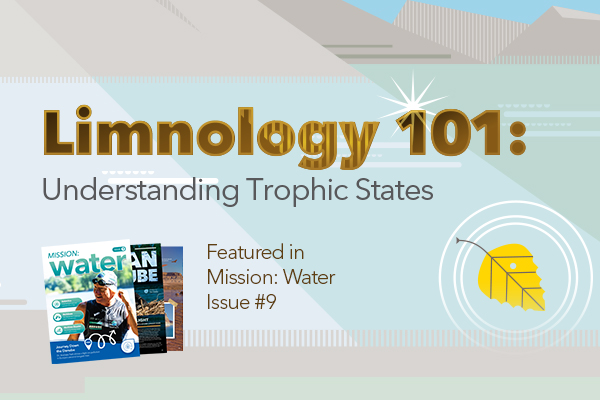
The Trophic State Index (TSI) separates lakes into different classes. This blog is adapted from an infographic from issue #9 of our Mission: Water magazine.
The TSI system considers water clarity and the water chemistry parameters total nitrogen, total phosphorus, and/or chlorophyll to determine the trophic state.2 Based on these data, lakes are separated into three general classes. Let’s explore each of them.
Oligotrophic: The Clear Solitudes
Oligotrophic lakes are often cold, deep, and found in areas with little nutrient runoff—they are typically located far from dense human populations. These lakes are also characterized as having incredibly clear, pristine water. Additional details include:
- Low nutrient concentrations and very little plant growth3
- Found in areas where soils have few nutrients3
- Typically clear (clarity > 13 ft; > 4 m), cold water2
- Water chemistry parameters:2
- Chlorophyll: <3 µg/L
- Phosphorus: <15 µg/L
- Nitrogen: <400 µg/L
- These lakes tend to be deep. Depending on conditions, dissolved oxygen levels near 100% can persist throughout the water column for the entire year.5
- In the U.S., fish found in oligotrophic lakes include lake trout, perch, and walleye.
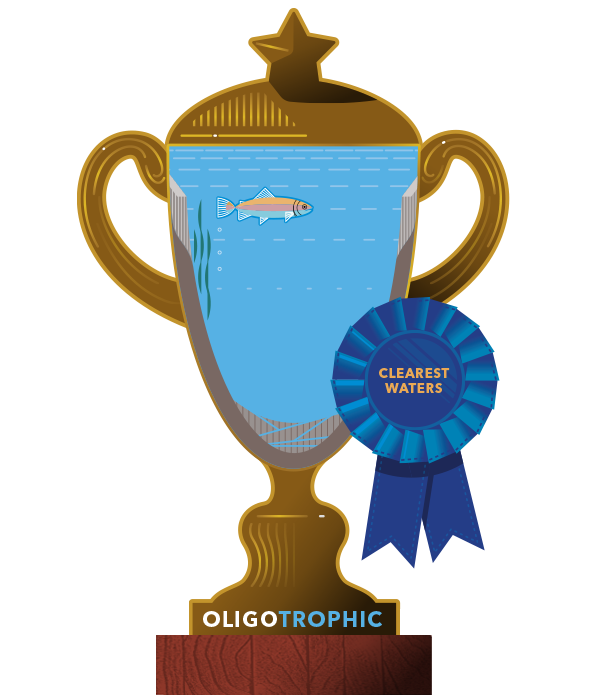
Oligotrophic lakes are known for being incredibly clear!
Nicknamed “the Pearl of Siberia” because of its crystal clear water, Lake Baikal is an excellent example of an oligotrophic lake. It holds some impressive lake records, as it’s the world’s deepest, oldest, and largest (by volume) lake. It is also a haven for wildlife, with nearly 2,000 animal species, about half of which cannot be found anywhere else in the world.4
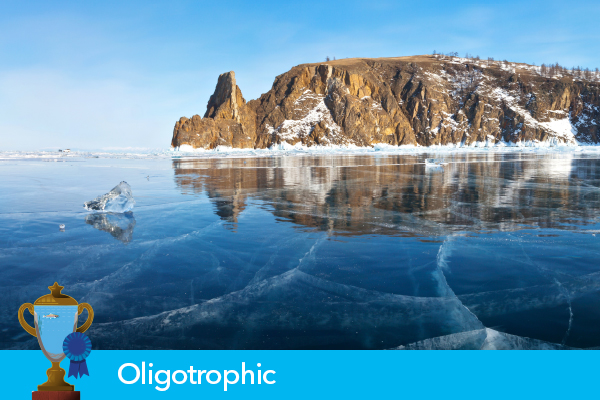
Lake Baikal—an oligotrophic lake—is the world’s deepest, oldest, and largest (by volume) lake.
Mesotrophic: Moderate Productivity
Mesotrophic lakes are moderately productive and have features of both oligotrophic and eutrophic lakes—more on eutrophic lakes later. These lakes are still relatively clear, but there can be a buildup of sediment and nutrients.
Additional details include:
- Falls between oligotrophic and mesotrophic lakes
- Moderately productive3
- Usually clear (clarity = 8 to 13 ft; 2.5 to 4 m)2
- Water chemistry parameters:2
- Chlorophyll: 3-7 µg/L
- Phosphorus: 15-25 µg/L
- Nitrogen: 400-600 µg/L
- In the U.S., fish in these lakes include musky, northern pike, and bass.
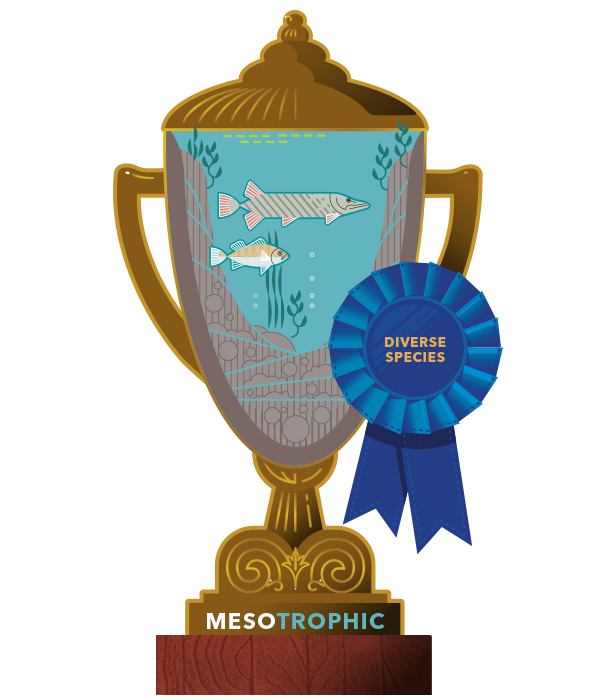
Mesotrophic lakes fit between oligotrophic and eutrophic lakes. They often host diverse populations of fish and aquatic plants.
Lake Ontario is the smallest of the Great Lakes (by surface area), but it’s ranked second in average depth. These unique features contribute to Ontario’s status as a mesotrophic lake.
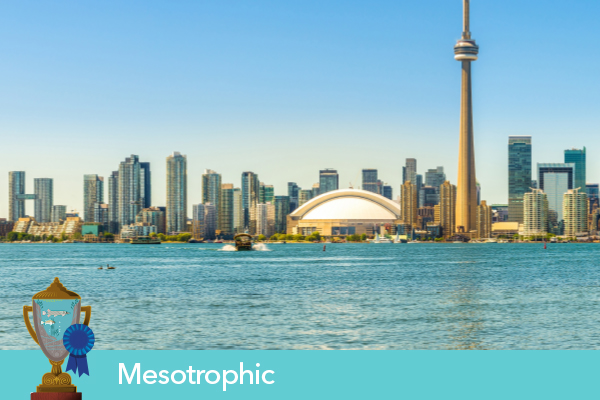
Lake Ontario—located along the border of Canada and the United States—is an excellent example of a mesotrophic lake. Located in the Ontario province of Canada, Toronto is the largest city along the lake’s shoreline.
Eutrophic: High-Nutrient Environments
Eutrophic lakes are shallow, nutrient-rich water bodies dominant in areas where humans have a significant environmental impact. These lakes can be plagued with frequent algal blooms, exacerbated by climate change and new pollution sources.
Although many eutrophic lakes are unhealthy due to pollution, it’s important to note that just because a lake is eutrophic does not always mean it has poor water quality. For example, a eutrophic lake is a welcome sight for those who love to fish for bass and catfish!
Additional details about eutrophic lakes include:
- High nutrient concentrations and a lot of plant growth–productivity is very high3
- Found in watersheds with rich soils and/or agricultural areas where fertilizer is used3
- These lakes are often shallow. The bottom layer can be anoxic (DO = 0 mg/L), especially in summer.5
- Light does not penetrate far into the water column (clarity = 3 to 8 ft; 1 to 2.5 m)2
- Water chemistry parameters:2
- Chlorophyll: 7-40 µg/L
- Phosphorus: 25-100 µg/L
- Nitrogen: 600-1500 µg/L
- Many will eventually become a marsh, bog, or other wetland area6
- Poor watershed management can cause lakes to become increasingly eutrophic3
- In the U.S., fish in these lakes include panfish, bass, catfish, and carp.
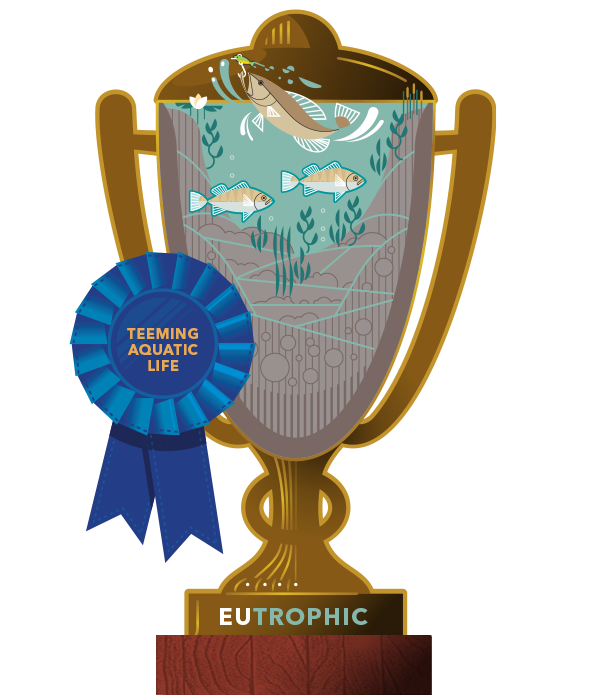
Eutrophic lakes have a lot of nutrient input, making them a very biologically productive environment.
A great example of a eutrophic lake is Lake Taihu, one of the largest freshwater lakes in China. In recent decades, population growth and local factories have resulted in a significant influx of nutrients into the lake.
An advanced state of eutrophic conditions—termed hypereutrophic—can occur when a lake has an exceptionally high level of biological productivity. Chlorophyll (>40 µg/L), phosphorus (>100 µg/L), and nitrogen (>1500 µg/L) are incredibly high compared to eutrophic conditions, and water clarity can be less than three feet (< 1 m).2
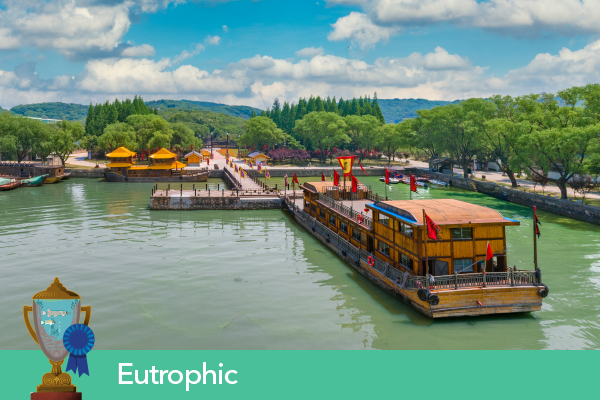
Located in Jiangsu province, Lake Taihu is one of the largest freshwater lakes in China. A significant influx of nutrients into the lake has occurred in the last several decades.
Natural vs. Anthropogenic Eutrophication
Lakes can naturally transition from young, oligotrophic lakes to those that are eutrophic as they fill with sediment and organic matter. Without the influence of humans, this transition occurs very slowly, typically over thousands of years.7
The eutrophication of a lake is rapidly accelerated by human activity in the watershed. A variety of pollution sources—resulting in increased nutrient inputs—can cause a pristine oligotrophic lake to become eutrophic within a few decades.7
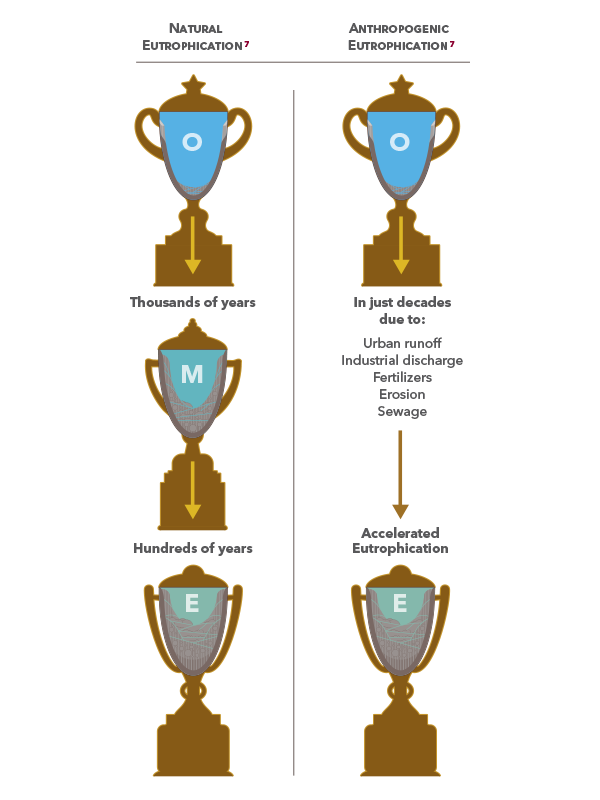
Without human influence, a lake can naturally transform from oligotrophic to eutrophic over thousands of years. However, human activity can result in a pristine lake becoming eutrophic within a few decades.7
Understanding the differences between oligotrophic, mesotrophic, and eutrophic lakes is essential for anyone engaged with these aquatic systems, whether for recreation, research, or policy-making. Each type has unique characteristics that dictate its ecological role, vulnerabilities, and contributions to broader ecosystems.

Sources: